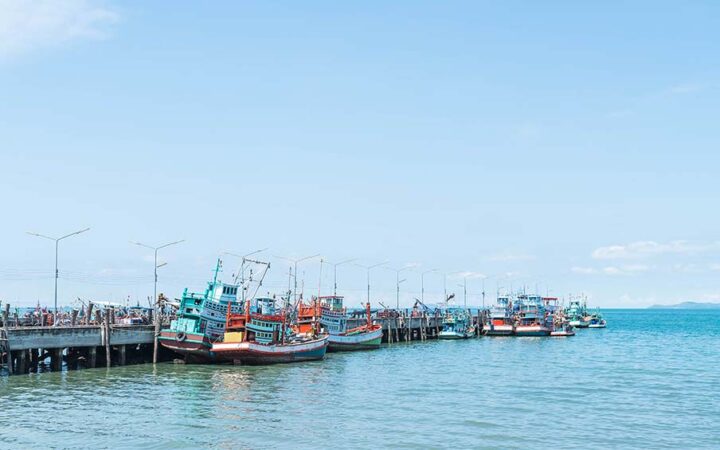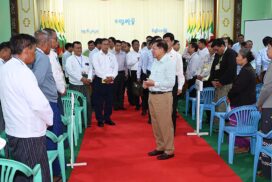Blessed with land and water resources, Myanmar possesses a long coastal line from the mouth of the Naf River in Rakhine State, the western part of Myanmar, to Kawthoung, the southernmost of the nation, which is 2,800 kilometres long.
The total coastal area of Myanmar is 1,384 nautical miles, which is long-formed with several small and large islands as well as beautiful archipelagoes. Myeik Archipelago is constituted of more than 800 islands accumulating natural resources such as above-ground, underground, above-water and underwater resources.
Myanmar’s total water area is 8,910 square miles (23,100 square kilometres), and an exclusive economic zone covers 205,706 square miles (532,780 square kilometres). The entire economic zone of the State is an area beyond and adjacent to the territorial sea. Such an exclusive economic zone extends to a distance of 200 nautical miles from the baselines.
Maritime zones comprise territorial sea, contiguous zone, exclusive economic zone and continental shelf. Myanmar’s marine fisheries waters mean the waters along the sea coast of Myanmar from the high tide mark toward the open sea, the waters on the seaside of the straight line drawn from one extreme end of one bank to the extreme end of the other bank of the river and creek mouths, the waters from the said high tide mark to the end of the Exclusive Economic Zone.
Inshore fishery means fishery carried out in the inshore area along the Myanmar coast as determined by the Director General of the Fisheries Department as an inshore fishery area. Offshore fishery means fishery carried out in the Myanmar marine fisheries waters as determined by the Director General as an offshore fishery area. As Myanmar is a sovereign country, everybody needs to follow any laws enacted by the State in operating their businesses or doing something concerning all the measures of the Republic of the Union of Myanmar. As such, not only Myanmar fishery entrepreneurs and fishermen but also those from foreign countries engaging in the fishery industry in Myanmar have to abide by the provisions of existing laws enacted by Myanmar governments in successive eras.
Myanmar citizens, foreign businesspeople, and those from the fishery industry must know the restrictions, prohibitions and penalties in Myanmar’s fishery sector. In this regard, Tatmadaw (Navy) and Myanmar Coast Guard are serving their defence and security duties in the Myanmar water territorial area. They will seize illegal fishermen and fishing trawlers for taking action against them under the law.
Myanmar authorities and relevant organizations are ready to take rescue and relief measures for those who face natural disasters and accidental dangers to life while legally doing fishery business in Myanmar’s waters. As such, any fishermen can seek help from these organizations for their survival in emergency cases or in natural disasters. On the other hand,
those organizations are searching for illegal fishery businesspersons in the seas to be taken action.
Businesspersons and those wishing to operate and those operating offshore and inshore fishery industries need to know the prohibitions of the Myanmar Marine Fisheries Law. The law states that no person shall engage in inshore and offshore fishery without a licence. The licence holder shall not violate any of the conditions contained in the licence. The holder of the licence shall not transfer his licence. No person shall engage in the industry with the licence obtained by way of transfer under Section 36 of the Myanmar Marine Fisheries Law. No person shall keep on board the fishing vessel explosive substances, poisons, chemicals, and other dangerous substances not permitted for use in fishing. No person shall dispose of living aquatic creatures or any material into the Myanmar Marine Fisheries Waters to cause water pollution or to harass fishes and other marine organisms. No person shall search for and collect any marine products without a licence.
Myanmar captures fisheries from the sea for the purpose of export and domestic consumption. Myanmar’s fishery industry exports a large volume of fishery products to China, Thailand, Bangladesh and other regional countries through land borders such as Htikhee, Mawtaung, Myawady, Myeik, Kawthoung, Sittway and Maungtaw border points as well as through the maritime trade route, generating millions of US dollar incomes on a yearly basis not only for the businesspersons but for the State.
The Department of Fisheries set a timetable for the non-fishery period all offshore trawlers must follow. Every year, the non-fishery period is set from May to July to set a time to regenerate various species of fish in the Myanmar water territorial area to avoid depletion of fishery deposits in Myanmar seas. According to the restrictions, all fishermen and fishing entrepreneurs need to prevent fishery processes in the seas totally.
In line with the economic objective of the State, which mentions Enhancing agriculture and livestock production with modern technologies for the benefit of all National people and promoting growth in other sectors of the economy for achieving national prosperity and food security, businesspersons have to produce foodstuffs based on agriculture and livestock raw materials as well as fishery products for ensuring local food security. That is why fishery businesspersons and fishermen have to take deserved rights and advantages in doing their businesses of offshore and inshore fisheries with might and main, whereas they have to be liable to follow the existing laws of the State. To ensure the sustainability of fish resources at Myanmar seas, all Myanmar citizens must conserve water resources, including fish deposits and aqua creatures and underwater resources such as coral reefs, seagrass, natural plants in the seas and various fish species.
Myanmar territorial seas: Remarkable fishery resources for domestic consumption and export purpose
- January 07, 2024
- 353













